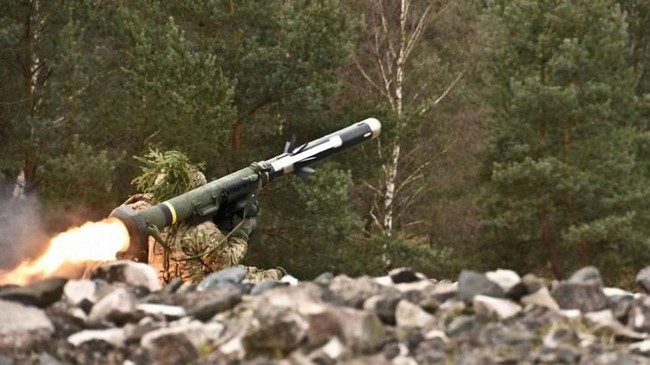Russia’s war on Ukraine isn’t even three months old. But already a 26-year-old American weapon has become a legend — and even a religious icon.
In fact, the weapon has proven so effective and deadly against Russian armor, that Joe Biden has sent fully a third of the U.S. Army’s stockpiles, which will take years to replenish.
It’s the Javelin, a complex weapon that’s surprisingly simple to operate as an anti-tank missile with an impressive kill rate that’s helped level the playing field for the underdog Ukrainian military against the once-vaunted, but now surprisingly inept Russian army.
Vladimir Putin’s forces were told they’d be welcomed as liberators in this “special operation,” which is not an invasion, you understand. Now, these forces have chosen to pull back in many places and simply fire thousands of artillery rounds blindly into cities, destroying thousands of civilian lives and the cities themselves.
Ukraine’s military, on the other hand, has sniped at least seven Russian generals to death along with numerous other senior officers and thousands of Russian invaders.
Many of these invaders died in an estimated 900+ burning tanks and vehicles that were supposed to slice through Ukraine’s third-rate military and take over its cities and the capital Kyiv in a matter of days while ousting the country’s elected government and implanting a puppet regime.
It hasn’t worked out that way.
The Javelin (so named because its flight mimics the arc of a thrown javelin) is a 46-pound, shoulder-fired missile carried by one man. With a viewfinder, he places the launch unit’s cursor on the target up to nearly three miles distant, locks the image into the missile’s memory, and fires.

The missile is thrown out of the tube before the propellant ignites and its guidance fins deploy under the control of its camera referencing the targeted info.
Such a soft launch system enables Javelins to be fired from inside buildings. And its thermal imaging sees through smoke or fog.
It’s a fire-and-forget weapon, meaning once launched, the soldier can relocate to avoid counter-fire or reload even before the first missile hits. Ukrainians have told of Russians breaking off an engagement at the whoosh of Javelin launches.
The Javelin’s sighting viewfinder is so precise it’s often used just for observation purposes without firing.
Once targeted, the missile’s memory is relentless, taking the weapon up to an altitude of 900 feet before plummeting onto the target’s top where armor is usually thinnest.
Most modern tanks are equipped with reactive armor, small explosive charges covering their outer skin, and designed to detonate incoming weapons before they can penetrate the armor.
But Javelin has its own minor charge that goes off instead, enabling it to disregard the reactive armor and do its lethal job. Javelins have also been used against helicopters and fired into caves with devastating effects.
NATO allies, including several former Soviet-bloc countries, have shipped tons of weapons, ammunition, and protective gear into their besieged neighbor, including their own anti-tank versions.
As usual, Joe Biden was late to act. But since March he’s dispatched or sought nine separate military aid packages for Ukraine, including a recent request for some $33 billion more in ammo, vehicles, artillery rounds, and such technical gear as radar that can track incoming shells back to their firing points for instant retaliation. Wednesday the House boosted that package to $40 billion before passage.
Russian forces have displayed terrible logistics and command structure, shoddy strategies, little initiative, low morale, and poor communications discipline, which Ukrainian and U.S. intelligence have exploited.
So poor were Russian communications that some units used cellphones stolen from Ukrainian civilians to talk to each other. Which made defenders’ electronic eavesdropping even easier.
As a result, Putin’s recent holiday speech was toned down and failed to mention victory on Victory Day. He seems to be settling in for a much longer war than he expected, refocused for the moment on eastern Ukraine, where he’s been fomenting an insurgency since annexing Crimea in 2014.
As our Army veteran colleague streiff has so skillfully pointed out here and here, Putin appears to be counting on an eventual waning of support for Ukraine among NATO allies.
So far, however, there’s no sign of that nor any diminution of the will of Ukraine’s defense forces — and their skill using thousands of Javelins on Russian tanks, personnel carriers, trucks, and even some low-flying aircraft.
Now, have some Russian troops actually retreated?
In 1994, Ukraine gave up its nuclear weapons in the Budapest Agreement among Russia and Western allies in return for their promises to protect its national sovereignty.
In 2014 when Putin first moved on Ukraine anyway to annex Crimea, the Obama-Biden administration helpfully shipped in blankets and field rations. Finally, Donald Trump shifted the aid to more effective lethal weaponry. Here’s a partial list of what Biden has dispatched so far.
Prime among these varied shipments are more than 6,000 Javelins, the product of a joint Lockheed Martin-Raytheon venture and more than one-third of the country’s arsenal.
U.S. troops in infantry training spend two weeks learning how to use and maintain Javelins and their central firing units. So generous has Biden been dispensing Javelins to Ukraine that supplies available for U.S. troops are rapidly diminishing.
Lockheed Martin has been building about 2,000 Javelins a year. Its executives say they hope to double annual production to 4,000. But that will take well into 2023 or later to implement.
Even at that expanded rate, however, it will take several years to replenish U.S. supplies, which are certain to be further depleted in the meantime. And the rebuilding process won’t be easy. Parts suppliers also must ramp up their production, which takes time and training. And the same for their suppliers.
Then there’s the broader shortage of computer chips. Every exploding Javelin not only takes out its target, but it also destroys more than 200 of its own working computer chips.













